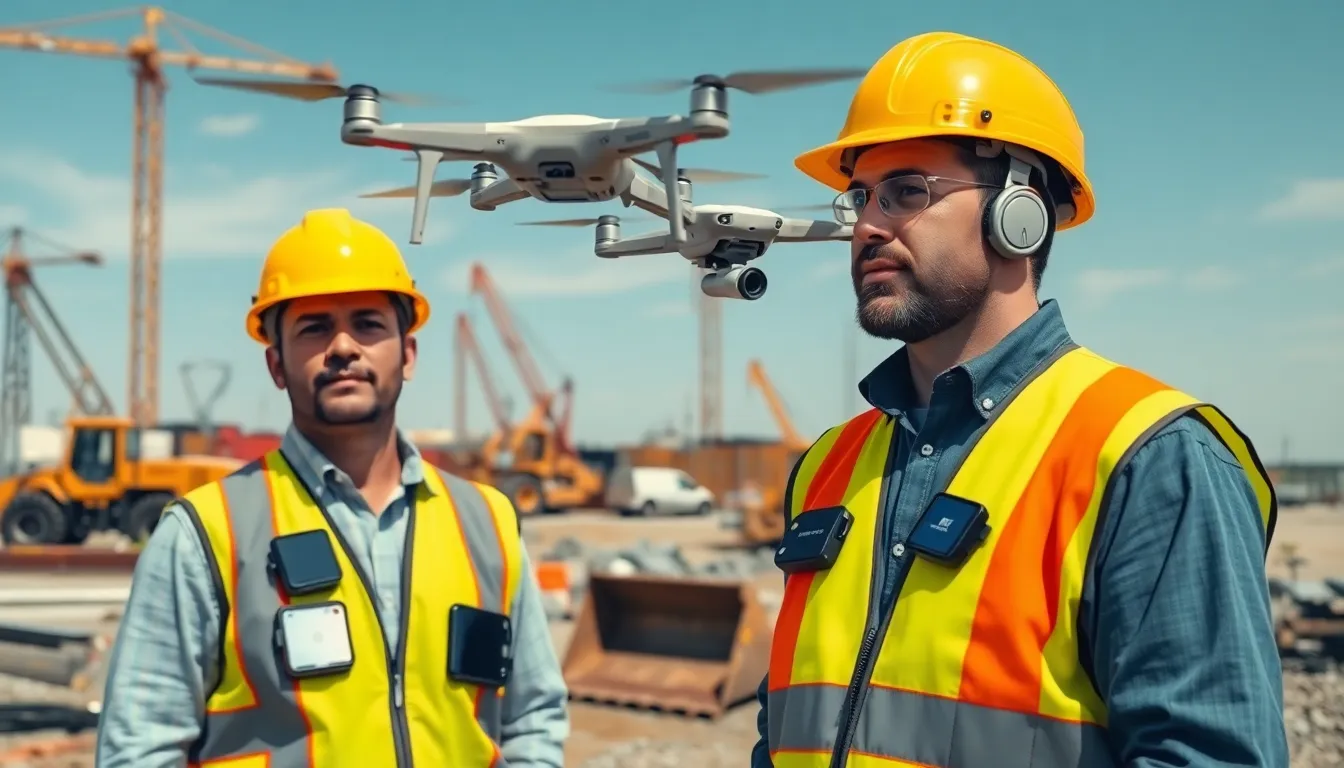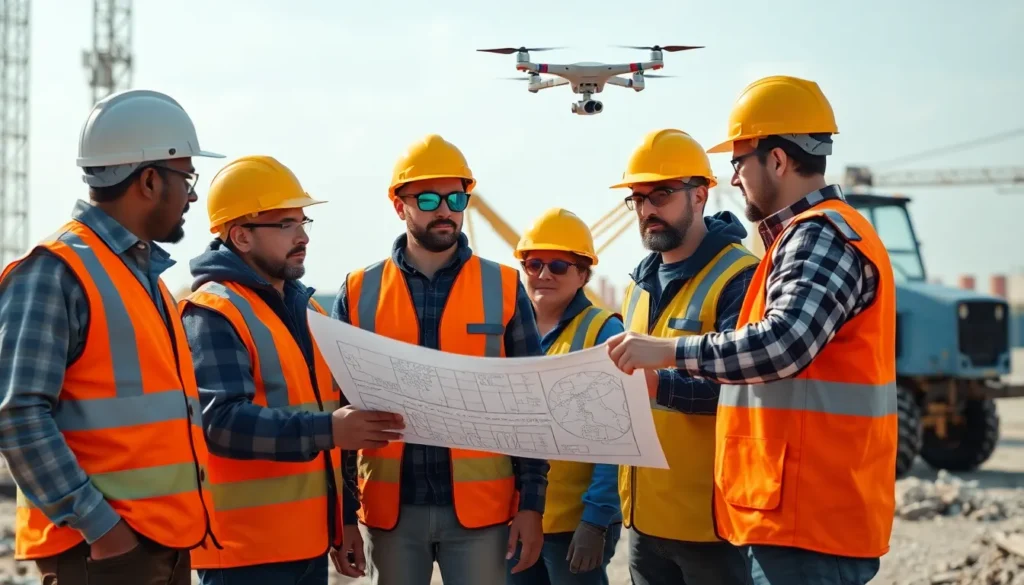Table of Contents
ToggleImagine a construction site where hard hats aren’t just for safety but also come equipped with smart technology. Welcome to the world of the Internet of Things (IoT) in construction, where bricks and mortar meet bytes and bandwidth. This isn’t just about fancy gadgets; it’s about transforming how projects are managed, making them smarter, safer, and more efficient.
Overview of Internet of Things in Construction
The Internet of Things (IoT) revolutionizes the construction industry by enabling real-time data exchange between equipment, workers, and project management systems. Smart sensors monitor site conditions, equipment performance, and material usage, ensuring efficiency in operations. Connected machinery reduces downtime, as predictive maintenance alerts teams to potential issues before they impact productivity.
Data analytics enhances decision-making by providing insights into project timelines and costs. Construction managers access real-time information, allowing them to reallocate resources swiftly. Drones equipped with cameras gather aerial data, facilitating site inspections and progress tracking without significant delays.
Collaboration improves through IoT platforms, connecting teams across various locations. Cloud-based applications allow project stakeholders to share updates instantaneously. Wearable technology enhances worker safety by monitoring vital signs and environmental conditions, reducing accident rates on-site.
Energy management plays a crucial role in sustainability efforts. IoT devices track energy consumption, helping teams optimize usage and minimize waste. Implementation of smart technologies contributes to greener construction practices through efficient resource management.
Adopting IoT in construction aligns with trends toward automation and digital transformation. As the industry embraces this innovation, companies gain a competitive edge by increasing efficiency and reducing costs. Future developments in IoT promise even greater impact, shaping the way construction projects unfold.
Benefits of IoT in Construction

IoT technology brings significant advantages to the construction industry by enhancing efficiency and improving safety.
Enhanced Efficiency
Real-time data collection enables project managers to monitor workflows and resource allocation continuously. Smart sensors track equipment usage, ensuring optimal performance and minimal downtime. Predictive maintenance alerts identify potential issues before they escalate, which prevents costly delays. Drones streamline site inspections and provide instant aerial views, improving decision-making speed. Mobile apps provide instant access to project data, enabling timely responses to evolving conditions on the site. Integration of IoT platforms fosters collaboration among various teams, enhancing communication and overall project coordination. With these advancements, construction companies maximize productivity and utilize resources effectively.
Improved Safety
Wearable technology plays a critical role in enhancing worker safety on construction sites. Smart helmets and vests monitor vital signs and environmental conditions, alerting workers to potential hazards. Safety data analytics identifies patterns in incidents, allowing teams to implement preventive measures. Real-time communication tools enable quick reporting of safety concerns, fostering a proactive safety culture. Remote monitoring of heavy machinery ensures that equipment operates within safe parameters, reducing accident risks. Overall, IoT contributes to safer work environments, benefiting both employees and organizations.
Challenges of Implementing IoT
Implementing IoT in construction presents numerous challenges that must be navigated effectively.
Security Concerns
Security vulnerabilities arise with the integration of IoT devices. Unauthorized access to data can compromise project confidentiality. Cyberattacks on construction systems may disrupt operations and lead to financial losses. Protecting against these threats requires robust cybersecurity measures, such as encryption and regular software updates. Construction firms must prioritize employee training to raise awareness of security best practices. Compliance with data protection regulations adds another layer of complexity, emphasizing the importance of securing sensitive information.
Technical Limitations
Technical limitations hinder the full deployment of IoT solutions in construction. Many existing systems may lack interoperability, making integration with new IoT devices difficult. Connectivity issues in remote sites can lead to inconsistent data transmission. Bandwidth constraints often limit the effectiveness of data collection and real-time monitoring. Additionally, the high costs associated with IoT infrastructure may pose significant challenges for small to medium-sized contractors. Addressing these limitations requires investment in reliable technology and comprehensive planning to ensure a seamless transition.
Key Applications of IoT in Construction
Various applications of IoT in construction optimize processes and enhance overall productivity. Two significant areas of impact are real-time monitoring and predictive maintenance.
Real-Time Monitoring
Real-time monitoring boosts project efficiency across multiple dimensions. Smart sensors track site conditions such as temperature, humidity, and noise levels, ensuring compliance with safety standards. Equipment performance is also monitored continuously, allowing teams to react promptly to any issues that arise. Data collected feeds into project management systems, providing insights that support better decision-making. Workers can access these insights through mobile apps, improving collaboration and communication. This ongoing monitoring fosters an adaptable work environment that can adjust based on immediate needs and conditions.
Predictive Maintenance
Predictive maintenance transforms equipment management in construction. IoT devices analyze historical data and performance metrics, identifying potential failures before they occur. These early warnings reduce unexpected downtime, keeping projects on schedule. Regular assessments generate maintenance alerts, allowing teams to address issues proactively. This approach saves costs associated with emergency repairs and loss of productivity. Integration of predictive maintenance into workflows not only enhances equipment lifespan but also promotes a safer work environment by mitigating risks associated with machinery malfunction.
Future Trends in IoT for Construction
Emerging trends indicate significant advancements in IoT’s role within the construction industry. Increased adoption of artificial intelligence (AI) alongside IoT enhances data analysis capabilities, leading to more accurate predictions and project planning. Companies are integrating machine learning algorithms to process data from construction sites, enabling quicker decision-making and optimized workflows.
Integration of robotics in construction represents another vital trend. Autonomous drones and robotic equipment streamline tasks such as inspections, material transport, and even physical construction activities, improving overall efficiency on job sites. Their ability to operate continuously reduces project timelines and labor costs significantly.
Remote monitoring technologies continue to evolve, offering increased connectivity and real-time data access. Workers can leverage these advancements through mobile applications, allowing seamless communication and instant sharing of project updates. Such connectivity fosters enhanced collaboration among teams spread across different locations.
Some organizations are prioritizing sustainability through IoT solutions that improve energy management. Smart building technologies monitor energy consumption and optimize resource usage, ultimately reducing environmental impact. These changes align with industry trends toward greener construction practices and compliance with stricter environmental regulations.
As cybersecurity becomes a focal point, companies are investing heavily in protective measures for IoT systems. Advanced encryption methods and secure data management practices aim to safeguard sensitive information while ensuring reliable system performance. Ongoing training for employees regarding security best practices further fortifies these efforts.
Lastly, enhancements in supply chain management featuring IoT tools allow for better tracking of materials and inventory. Real-time updates on supply levels help prevent delays and optimize purchasing strategies, ensuring that projects stay on schedule. These developments collectively position IoT as a cornerstone of the future construction landscape.
The Internet of Things is undeniably transforming the construction industry. By enhancing efficiency and safety through real-time data and smart technologies, it’s paving the way for a more connected and productive work environment. As companies embrace these advancements, they’re not only optimizing workflows but also addressing challenges like cybersecurity and interoperability.
Future innovations in IoT promise to further revolutionize construction practices. With the integration of AI robotics and improved energy management, the sector is set to become even more efficient and sustainable. Embracing these changes will be crucial for organizations aiming to stay competitive in an evolving landscape. The journey toward a smarter construction industry has just begun, and the potential is limitless.







